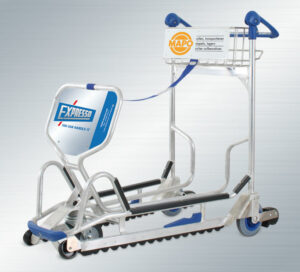Four different shopping cart portrayals in Europe (Denmark, Italy, Germany and Switzerland)
Shopping carts in Denmark
In Denmark, we generally use two different forms of vehicles to move purchased goods around. The shopping basket and the shopping cart. They are found almost exclusively in places to shop for food and household items, as opposed to stores of consumer goods such as garments, electronics, toys, makeup, etc. The Danish name of it is ‘indkøbsvogn’ or ‘indkøbskurv’ which also refers to the activity of food and household purchases [indkøb] rather than shopping [shoppe/shopping], which is seen as a separate leisure activity, and therefore also creates a different mental reference due to the linguistic relativism.
Shopping carts in Denmark are found in supermarkets and hypermarkets. They are commonly made out of metal and are equipped with a seat that can be folded into the cart, near to the handle. People use these for their purse and bag, or as child seats, where the child is facing the parent. The carts are designed to fit into each other, to take up less space, which can create long chains of interlocked vehicles that can be easily moved. Most carts require a 10dkkr [coin] deposit, to detach it from the others.
The Shopping basket comes in two versions: One meant for carrying and one slightly larger with wheel and a handle, that allows people to drag the cart behind them. The basket is more or less the same at all stores but does indicate belonging by applying the colour scheme of the store, and sometimes the logo on the handle. The baskets are designed to be stackable, so that they can be easily moved from the register and exit to the entrance, to create a full circle of use to reuse.
While the shopping cart is used in hypermarkets, the basket is more commonly used in small and medium-sized stores; The cart is used for families and big purchases as it takes up much of the physical space in the store. If a store was to accommodate more carts, it would take up more product space. In the larger cities where the shops are also smaller, it is common to not have or at least not use the carts, even if one is doing a large purchase. This could also be due to the fact that fewer people have cars in larger cities and would, therefore, wish to transport fewer products home.
The shopping cart or basket is brought around the store. If people leave it, they only leave it shortly to gather some goods and return as a yoyo. In this way, it becomes organizes a central base of belonging in an otherwise foreign environment.
Both versions seem to be crude and simple versions of the technology. We do not use special scanners or screens. Shopping is done the same way as it has been for the last 30 years.
Shopping carts are at times repurposed by young people making trouble and playing around or by homeless people; however, neither of these are commonly seen. Removing, the shopping cart from it natural bounds is not socially permitted, and will cause people to stare, comment or react.
While it is permitted to carry goods around in the store in self brought bags and baskets, this is highly unusual. People use the in-store basket as a norm (Explicating that would require more in-depth investigation). The two separate containers will be carried around the store simultaneously - never left outside. Once you enter the bounds of the store the home-brought multipurpose basket is transformed from pure to danger (Douglas 1966); adversely the stores shopping basket can be seen as pure within the store, and danger outside the store.
Small fabric trolleys on wheels are very rarely seen, and if so, they are usually used by people who have a need to log around things, due to precarious life situations, such as partial homelessness or lack of social support systems or economic affluence – two things that otherwise enable and support food shopping structures in Denmark (however, I will not get into that as it moves off-topic for now).
Shopping carts in Italy and the particular case of Venice
Shopping carts in Italy are a “must-have” for every supermarket. Even the small supermarkets have them. Some shops decided to solve the space issue by simply using smaller carts or by using shopping baskets with wheels. In Italy the cuisine and the meals are not only a matter of food but also a matter of culture, these are essential parts of the day and their symbolic value is very high, this is reflected also in the shopping behaviour and in the way the shopping carts are used and the frequency of their use. Usually, the consumers drive to the supermarket and acquire the groceries usually for the whole week. Usually, you need a 50c or 1€ coin to unlock the cart and as a standard, they have the foldable seat for the children or the purse. The supermarkets also provide its customers with baskets that can either have wheels or be carried by hand, in both cases these are for the people that have to buy just a few things. This is the typical use but it is important to notice that during the COVID-19, shopping carts became a tool to maintain social distance and therefore to protect ourselves.
Another very interesting topic to be briefly discussed is the use of the carts and shopping carts in Venice. The city of Venice is certainly wonderful, but its stunning beauty also hides significant problems of living in this city. As you know, there are no cars or bikes in Venice and the city has more than 400 bridges and the most common methods to move things around is by using a shopping cart, or different kinds of carts. In Venice, the shopping carts are peculiar, usually, they are similar to trolleys. Some of them have 2 groups of 3 wheels that allow them to pull them easily up the stairs of the bridges. Similarly, porters, mailmen, garbage collectors and every other person that has to move goods around the city of Venice uses even a cart or a shopping cart.

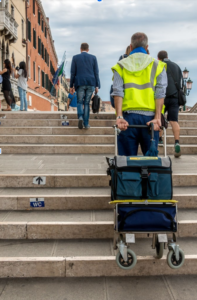
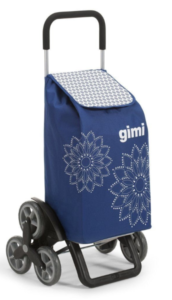
In the first picture we have a luggage porter in Venice, then a mailman in Venice with his cart (branded Poste Italiane). The same idea applies to the man with his shopping cart on the stairs. The third picture shows the typical shopping cart in Venice.
Shopping carts in Lüneburg, Germany
Participatory observation, Tuesday 26th of May at 4:30 PM
In order to investigate the socio-technical relations of shopping carts in supermarkets in Lüneburg, I went to one of the bigger supermarkets, close to the city centre, to buy groceries.
The shed, where all the shopping carts are stored, is located approx. 20 meters from the supermarket's entrance. Every customer is required to pick up a shopping cart to enter, except for two people going into the market together. No coins are necessary to access the cart. The cart is a metal gridded container with four wheels. There are two separate doors for the entrance and the exit. In front of the shopping cart shed an employee of the supermarket takes back the carts and disinfects its handles.
Entering the supermarket most people move into the same direction. In general, most customers move forward and don't turn around. In the aisles, two shopping carts can pass or stand next to each other horizontally. When people pass each other in an aisle, they tend to do so rather quickly. Sometimes a person leaves an aisle backwards, carefully looking before doing so. Most people keep their hands on the cart a lot or leave them standing a short distance to grab a product. Most customers are by themselves but if there is another person with them, they tend to stay closely together. The only person wandering around the store without a cart or a partner with a cart in sight was a little kid looking at candys. Many customers lean onto their carts as they move through the market. I often felt the urge to move forward because other shopping carts appeared behind me, wanting to go into my direction or pass by me. Other people avoided going into the same aisle when they saw a person in that aisle. At the checkout, the carts were also used to maintain distance while standing in line.
In general, I had the impression that people rarely moved away from their carts, as they may symbolize a safe island in the market full of other people that could potentially be a threat to their health.
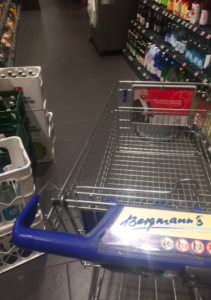
Shopping carts in Switzerland
For many people who are usually at home a lot (such as students or retired people), shopping is a good excuse to get out of the house, get some fresh air and see other people. They don't buy too much: only for 1-3 days and so the shopping cart was an uncommon object for them. Except for a few elderly people, who also use the shopping trolley as a walker.
Since the current pandemic, the situation looks different: Either these elderly people can no longer go shopping themselves and those who do, hoard as much stock as possible so that a shopping trolley is unavoidable.
Already before the pandemic, but now very much in use, are the self-scanning handheld devices. To get a scanner in the entrance area of the shop is to be a member of the loyalty program. This is then placed in the shopping cart on a special holder. At the end of the shopping you only have to unscan with the scanner itself. The two retailers Migros and Coop promise three advantages:
- After scanning, the articles can be packed directly
- The total purchase amount is continuously visible on the hand scanner
- No queuing at the cash desk
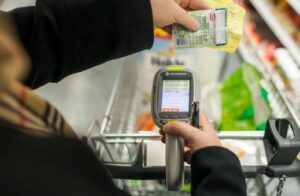
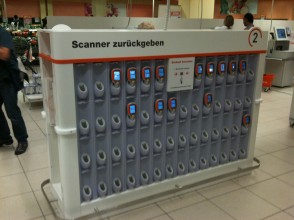
This technology has existed since 2011, but only now, since the introduction of COVID-19, many more people are using this kind of shopping - see picture with one station and few self-scanners.
The shopping trolleys - in Swiss German "Wägeli" - are a symbol for shopping, but also for the homeless and the youth. They are used in a different context, as a means of transport for your only belongings. But some young people like to steal shopping trolleys and use them for pranks such as cart racing. This problem confronts the manufacturers here with tricky tasks of how to solve the whole issue. The well-known problem of solving the trolley with a coin only pursues the goal that one is forced to keep order and not leave it lying around. But now there are attempts where the wheels of a shopping trolley get blocked as soon as they leave a certain distance from the shop.
Switzerland remains a little hub for innovation. Did you know that the well known baggage trolley, which has below attachments to roller escalators, was a Swiss idea?
